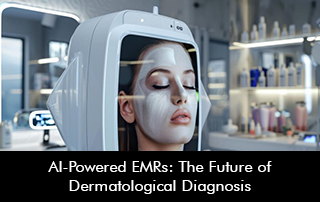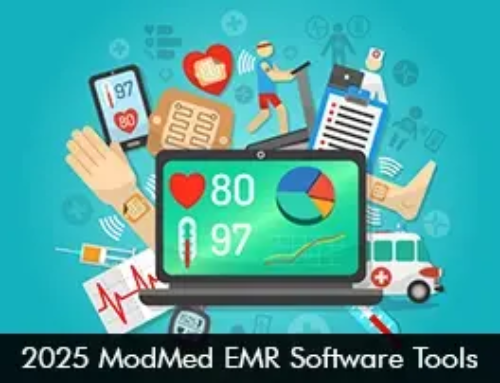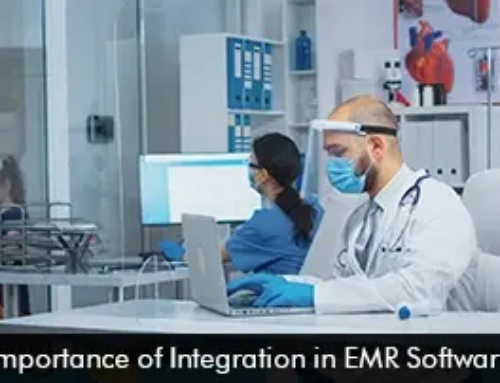Electronic Medical Records (EMR) have revolutionized dermatology practice, enhancing patient care, streamlining workflows, and now, with the integration of Artificial Intelligence (AI), transforming diagnostic capabilities. This evolution represents a paradigm shift in how dermatologists manage patient information, conduct diagnoses, and plan treatments.
Traditional EMR Benefits in Dermatology
Enhancing Patient Care
-
Comprehensive Documentation:
EMRs capture detailed patient histories, including allergies, medications, and past treatments.
-
Visual Data Management:
Specialized dermatology EMRs offer features for storing and comparing high-resolution skin images over time.
-
Efficient Treatment Planning:
EMRs facilitate the creation of comprehensive treatment plans, including medication schedules and follow-up appointments.
Streamlining Workflows
-
Customizable Templates:
Speed up documentation for common skin conditions.
-
E-Prescribing:
Reduce errors and improve medication management.
-
Integrated Scheduling:
Optimize patient flow and reduce wait times.
The Evolution of EMR in Dermatology: From Digital Records to AI-Powered Diagnosis
As EMR systems evolve, the integration of AI is opening new frontiers in dermatological care:
Advanced Diagnostic Support
-
Machine Learning Algorithms:
AI-enhanced EMRs analyze vast skin image databases, recognizing patterns and anomalies.
-
Real-time Analysis:
Provide instant differential diagnosis suggestions as dermatologists input patient data and images.
-
Continuous Improvement:
Each new case enhances AI accuracy, creating an evolving knowledge base.
Transforming Skin Cancer Detection
-
Early Melanoma Identification:
AI algorithms show promise in detecting early-stage melanomas often missed by the human eye.
-
Risk Stratification:
Analyze patient history and genetic data to identify high-risk individuals for targeted screening.
-
Biopsy Reduction:
AI-assisted diagnosis helps reduce unnecessary biopsies, saving time and resources.
Data Analysis and Research
-
Population Health Management:
EMRs with AI capabilities enable analysis of skin condition trends across diverse populations.
-
Clinical Research Support:
Aggregated, AI-analyzed data from EMRs can significantly advance dermatological studies and clinical trials.
-
Quality Improvement:
AI-driven performance metrics help identify areas for improving patient care and practice efficiency.
Telemedicine Integration
-
AI-Enhanced Remote Consultations:
Combine EMR data with AI analysis for more accurate teledermatology diagnoses.
-
Secure Image Sharing and Analysis:
Patients upload skin images for AI pre-screening before dermatologist review.
-
Intelligent Follow-up Care:
AI algorithms help determine optimal follow-up schedules for chronic skin conditions.
Challenges and Ethical Considerations
-
Data Privacy:
Balance the need for large AI training datasets with patient privacy concerns.
-
AI Bias:
Ensure AI models are trained on diverse skin types to avoid racial and ethnic biases in diagnosis.
-
Human Oversight:
Maintain the crucial role of dermatologists in interpreting AI suggestions and making final diagnoses.
The Future of EMR in Dermatology
As AI-powered EMRs continue to evolve, we can expect:
- Integration of 3D imaging and spectral analysis for comprehensive skin assessments.
- AI-driven personalized treatment plans based on individual patient data and global treatment outcomes.
- Collaborative AI networks allowing dermatologists worldwide to contribute to and benefit from a shared knowledge base.
Leading EMR Solutions in Dermatology
The dermatology field has specific EMR needs, and several systems have emerged as leaders in addressing these requirements:
Modernizing Medicine‘s EMA:
Designed specifically for dermatology, EMA is widely recognized for its specialty-specific workflows, adaptive learning, and intuitive interface. It offers features like built-in dermatology protocols and a touch-based system for efficient charting.
Nextech for Dermatology:
Tailored for dermatological practices, Nextech provides comprehensive EMR and practice management solutions. It offers specialized tools like before-and-after photo management and customizable dermatology templates.
patientNOW:
This EMR system caters specifically to dermatology and plastic surgery practices. It includes features like a body map for precise lesion tracking and integrated marketing tools for aesthetic procedures.
Encite by CareCloud:
While not exclusively for dermatology, Encite has gained popularity among dermatologists for its customizable workflows and robust imaging capabilities, crucial for skin condition documentation.
AdvancedMD for Dermatology:
This system offers specialized dermatology templates and workflows, along with integrated practice management features tailored to dermatology clinics.
MDconnection:
Specifically designed for dermatology practices, MDconnection offers a comprehensive suite of tools including customizable dermatology templates, integrated scheduling, and billing features tailored to dermatological procedures and treatments.
These EMR solutions stand out for their focus on dermatology-specific features, including advanced imaging capabilities, specialized templates, and workflow optimizations tailored to skin care practices. As the field continues to evolve, especially with AI integration, these systems are likely to adapt and offer even more sophisticated tools for dermatological care.
The fusion of traditional EMR capabilities with cutting-edge AI represents the future of dermatological practice. While challenges remain, particularly in data privacy and ethical AI use, the potential for improved patient outcomes and more efficient dermatological practices is immense. As we embrace this technological revolution, it’s clear that the future of dermatology is not just digital, but intelligently augmented, promising a new era of precision in skin care management.








